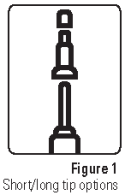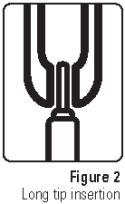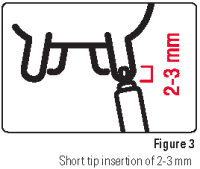Udder Seal
This treatment applies to the following species:Dry Cow Intramammary Teat Sealant Device
NON-ANTIBIOTIC
Each syringe contains 4 g intramammary paste
Containing 65% Bismuth Subnitrate
For animal use only. Not for use in humans. Keep out of reach of children.
Read Entire Package Insert Carefully Before Using This Product
Udder Seal is a sterile, antibiotic-free, off-white smooth paste. It is presented, ready to use, in syringes, each containing 4 g of intramammary infusion composed of 65% Bismuth Subnitrate, in a mineral oil vehicle. Udder Seal is indicated as an aid in the prevention of new intramammary infection throughout the dry period by providing a malleable barrier in the teat canal. This results in a reduction in the incidence of clinical mastitis in the dry period.
It is recommended that Udder Seal be used as part of a herd approach to dry cow management and mastitis control.
WITHDRAWAL INFORMATION: For use in dry cows only. Zero-day milk and meat withdrawal when used alone. If Udder Seal is administered following an antibiotic infusion, the withdrawal periods for meat and milk for the antibiotic must be observed.
Precautions
For animal treatment only. If Udder Seal gets on skin, wash with soap and warm water. If accidentally administered to a lactating cow, product can be stripped out by hand. A safety data sheet (SDS) may be obtained by calling 800-821-5570.Adverse Reactions
Mastitis-causing bacteria introduced into the teat at the time of infusion of Udder Seal have been associated with adverse reactions. Each teat must be cleaned and disinfected prior to infusion of Udder Seal. See below for instructions for administration of infusion products.Storage
Udder Seal should be stored at room temperature 60°-85°F (15°-30°C). In very cold temperatures Udder Seal may become difficult to administer and should be warmed to room temperature. In order to facilitate administration during cold periods, a watertight container or bucket containing Udder Seal syringes can be lowered into a larger container filled with warm water. To avoid potential contamination, individual tubes should not be immersed in water.Udder Seal Indications
Udder Seal is intended as an aid in the prevention of new intramammary infections of cattle throughout the dry period.
Dosage and Administration
After last milking at dry-off or during last two months before first calving in non-lactating first calf heifers, clean and disinfect the teats with alcohol wipes. Infuse the entire contents of one syringe of Udder Seal into each quarter by inserting the nozzle into the teat and applying gentle continuous pressure to the plunger until the paste is expressed. Do not massage teat or udder following infusion. If an antibiotic is infused into the teat, the teat should be re-wiped with an alcohol wipe prior to infusion with Udder Seal. A clean, disinfected and dry teat is essential, as Udder Seal possesses no antimicrobial activity.Udder Seal has the option to either use the short or the long tip of the syringe (Figure 1).

Typical insertion using the long tip option is shown in Figure 2.

According to National Mastitis Council recommendations, using the short tip (Figure 3) is preferred because it has been shown to result in fewer new intramammary infections. Studies recommend partial insertion of 2-3 mm to avoid increase in infection and damaging of the teat canal.1,2

REMOVAL: Do not remove Udder Seal by action of the milking machine. To reduce the potential for Udder Seal accumulation in milking machines, aggressively hand-strip Udder Seal out of every quarter, 10 to 12 strips per quarter, before milking fresh cows. Bucket-milk fresh cows for a minimum of three milkings, if possible.
Simple steps to avoid introducing infections during administration of intramammary infusions.
1. Do not place individual syringes directly in warm/hot water during cold weather.
2. Dry cows off abruptly rather than gradually.
3. Clean teat ends as thoroughly as possible with alcohol and leave to air dry.
DO NOT use water with or without disinfectant.
4. Clean the two teats furthest away first, followed by the two closest.
5. Ensure the teats are clean and dry before infusing Udder Seal. Take care to avoid contamination of the syringe nozzle. Careful insertion of the Udder Seal syringe nozzle with minimum penetration into the teat canal is recommended.
6. Infuse the teats in the opposite order to cleansing: i.e. infuse the closest two teats first, followed by the two furthest away. While administering, ensure the product remains in the teat cistern and canal rather than in the udder. Do not massage the teat or udder after insertion of Udder Seal.
7. After infusing, dip teats in teat dip or spray with disinfectant and leave cows standing in yard for at least half an hour to allow the teat canal to close.
8. Check cows regularly for signs of mastitis during the first week after drying off.
Use Only as Directed
Not for Human Use
Distributed by: Peak Marketing, LLC, 100 S.E. Magellan Drive, Blue Springs, MO 64014
Product of Germany
1. Boddie RL, Nickerson SC. Dry cow therapy: Effects of method of drug administration on occurrence of intramammary Infection. J Dairy Sci. 1986; 69:1, 253-257.
2. McDougall S. Management factors associated with the incidence of clinical mastitis over the non-lactation period and bulk tank somatic cell count during the subsequent lactation. NZ Vet J. 2003; 51:2, 63-72.
|
144 Syringes |
ISS22XB08 US/L761/0 |
CPN: 1084434.0
100 S.E. MAGELLAN DRIVE, BLUE SPRINGS, MO, 64014
| Telephone: | 816-229-9101 | |
| Toll-Free: | 800-821-5570 | |
| Fax: | 816-224-3080 | |
| Website: | www.durvet.com | |
| Email: | info@durvet.com |
 |
THIS SERVICE AND DATA ARE PROVIDED "AS IS". DVMetrics assumes no liability, and each user assumes full risk, responsibility, and liability, related to its use of the DVMetrics service and data. See the Terms of Use for further details. |

Copyright © 2024 Animalytix LLC. Updated: 2024-02-27
